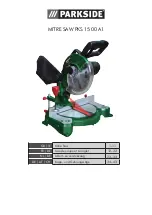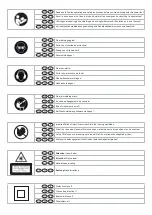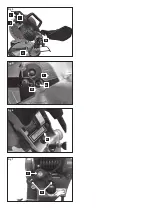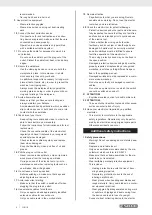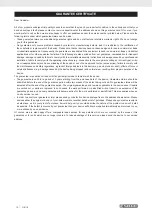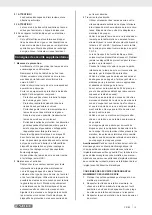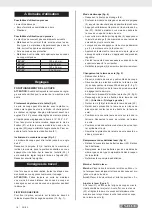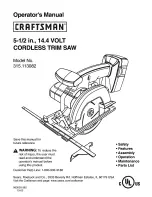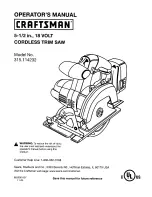
3
GB/IE
is defective, the power can fail when starting the machi-
ne. This could influence other machines (e.g. blinking
lamps). If the electrical power corresponds to Zmax <
0.27, such disruptions should not occur. (However, if
they do, inform your specialist dealer).
•
The specified vibration emission value has been
measured according to a standardised testing
procedure and can be used for comparison of one
electric tool with another;
•
The specified vibration emission value can also be
used for an initial assessment of the load.
Warning:
• The vibration emission value can vary from the
specified value during the actual use of the electric
tool, depending on the type and the manner in which
the electric tool is used;
• Try to minimise stress from vibrations as low as
possible. Some examples of means for reducing the
vibration stress are wearing gloves while using the tool
and limiting work time. In the process all parts of the
operating cycle must be taken into account (such as
times in which the electric tool is switched off or time
in which it is switched on, but is not running under a
load).
Proper use
The mitre saw is used for the cutting of wood and pla-
stic, according to the machine size.
Warning!
The supplied saw blade is only intended for
the sawing of wood! Do not use this blade for the saw-
ing of plastic!
The saw is not suitable for the cutting of firewood.
The machine may only be used in the intended man-
ner.
Only suitable saw blades may be used for the machi-
ne. The use of any type of cutting wheels is prohibited.
An element of the intended use is also the observan-
ce of the safety instructions, as well as the assembly
instructions and operating information in the operating
manual.
Persons who operate and maintain the machine must
be familiar with the manual and must be informed
about potential dangers.
Any use beyond this is improper. The user/operator,
not the manufacturer, is responsible for damages or
injuries of any type resulting from this.
In addition, the applicable accident prevention regulati-
ons must be strictly observed.
Other general occupational health and safety-related
rules and regulations must be observed.
The liability of the manufacturer and resulting dama-
ges are excluded in the event of modifications of the
machine.
Despite use as intended, specific risk factors cannot
be entirely eliminated. Due to the design and layout of
the machine, the following risks remain:
•
Contact with the saw blade in the non-covered saw
area.
•
Reaching into the running saw blade (cutting injury).
•
Kick-back of workpieces and workpiece parts.
•
Saw blade breakage.
•
Ejection of faulty carbide parts of the saw blade.
•
Hearing damage when the necessary hearing pro-
tection is not used.
•
Harmful emissions of wood dusts during use in enc-
losed areas.
Please observe that our equipment was not designed
with the intention of use for commercial or industrial
purposes. We assume no guarantee if the equipment
is used in commercial or industrial applications, or for
equivalent work.
Important information
Attention!
The following basic safety measures must
be observed when using electric tools for protection
against electric shock, and the risk of injury and fire.
Read all these notices before using the electric tool
and keep the safety instructions for later reference.
Safe work
1
Keep the work area orderly
–
Disorder in the work area can lead to accidents.
2
Take environmental influences into account
–
Do not expose electric tools to rain.
–
Do not use electric tools in a damp or wet envi-
ronment.
–
Make sure that the work area is well-illuminated.
–
Do not use electric tools where there is a risk of
fire or explosion.
3
Protect yourself from electric shock
–
Avoid physical contact with earthed parts (e.g.
pipes, radiators, electric ranges, cooling units).
4
Keep other persons away
–
Do not allow other persons, especially children,
to touch the electric tool or the cable. Keep them
away from your work area.
–
The operating person must be at least 18 years
of age; trainees must be at least 16 years, ho-
wever only under supervision.
5
Securely store unused electric tools
–
Unused electric tools should be stored in a dry,
elevated or closed location out of the reach of
children.
6
Do not overload your electric tool
–
They work better and more safely in the specified
output range.
7
Use the correct electric tool
–
Do not use low-output electric tools for heavy
work.
–
Do not use the electric tool for purposes for which
it is not intended. For example, do not use hand-
held circular saws for the cutting of branches or
logs.
–
Do not use the electric tool to cut firewood.
8
Wear suitable clothing
–
Do not wear wide clothing or jewellery, which can
become entangled in moving parts.
–
When working outdoors, anti-slip footwear is
Summary of Contents for 102787
Page 5: ...Fig 4 2 3 27 26 1 Fig 5 28 29 6 Fig 6 30 Fig 7 32 31...
Page 50: ......


